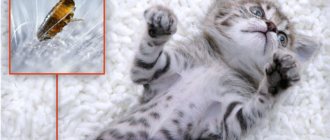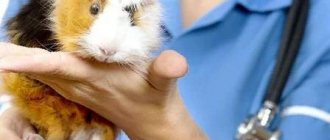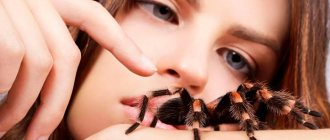What lice eaters look like and how dangerous they are in guinea pigs
Few of the owners of these pets know what lice eaters in guinea pigs look like and how dangerous they are.
Let's start by describing the appearance of small parasites:
- Lice eaters are colored pale yellow. However, there are variations from yellowish to pale gray.
- Parasites of this species are inactive and cannot be compared with nimble fleas and even lice. They prefer to sit quietly in place, securely attached to the hair near its base.
- The body of these parasites is shortened, angular, and the head is very massive and large. In this way, lice eaters are radically different from their distant relatives, lice.
Unlike many types of ectoparasites, lice eaters themselves are relatively harmless. They do not feed on blood or lymph, contenting themselves with eating hair and pieces of dead skin. In addition, they do not cause wild itching and other unpleasant sensations that are so annoying to animals with fleas and other bloodsuckers.
But why are they dangerous?
- Massive invasion can lead to a significant thinning of the animal’s coat. A pig, especially a long-haired one, can turn into something like an old, moth-eaten coat.
- Lice eaters are frequent carriers of dangerous diseases. Some of them are dangerous to humans.
- With severe infestations, the animal will feel some discomfort. Because of this, the “pig” may lose his appetite, which will inevitably lead to exhaustion, as well as a significant weakening of the immune system. All this can lead to the death of the pig from any bacterial, viral or fungal infection.
- They cause a fairly strong allergic reaction.
Ectoparasites
Skin parasites in guinea pigs belong to the group of ectoparasites.
The most common among them are lice and ticks, as well as lice and fleas. The first symptom of infection with any of the skin parasites is severe itching, redness and baldness of the infected areas of the skin. Skin parasites cause various diseases, most of which lead to exhaustion of the animal, the appearance of numerous purulent ulcers on the body and even death. Cat fleas are most common in guinea pigs. They can get on the animal from another animal, from the street, and a person can also become a carrier of fleas. Symptoms of the appearance of parasites are itching, local hair loss, and the presence of scratched wounds. If there are too many fleas, this can lead to anemia, exhaustion, and blood poisoning. Detecting fleas is not difficult - you can use a regular fine-tooth comb for fur.
The pig needs to be combed well and checked to see if any insects are stuck between the teeth of the comb.
Treatment of fleas is not complicated, but it requires attention and treatment of not only the sick animal, but also all other pigs. The animal should be treated with any shampoo or spray containing pyrethritol. The entire cage should be washed with the same shampoo, the bedding should be changed and the entire area around the cage should be treated. The procedure should be repeated after ten days and, if necessary, after another ten days. Usually two procedures are enough to destroy not only insects, but also their larvae.
Guinea pigs are most often parasitized by two types of mites: the scabies mite and the fur mite.
Endoparasites are parasites that live in the internal organs of a guinea pig. They cause great harm to health and cause not only various poisonings, but also lead to disruption of the functioning of internal organs, as well as the death of the animal. Most often, a guinea pig suffers from:
- worms,
- liver flukes.
Worms
These parasites not only absorb nutrients, but also lead to intoxication and depletion of the body. Typically, guinea pigs are susceptible to infection with two types of worms:
- tape or flat,
- round.
Adult flatworms are parasitic in the intestines and have a ribbon-shaped body. The embryos of worms, having entered the animal’s body along with low-quality food, can drill through the wall of the small intestine and enter the blood. They are able to move freely throughout the body through the circulatory system and settle in the lungs, liver, and brain, which will lead to the rapid death of the animal.
Worm larvae are dangerous not only for guinea pigs, but also for humans. An infected animal can be easily identified by lethargy and drowsiness, weight loss, increased appetite and thirst. If the infection is severe, then in the animal’s feces you can see not only worm larvae, but also adult individuals. And with a very severe infection, worms can crawl out of the anus.
Roundworms vary in appearance and can be shaped like a thin thread or a grain of rice. Some are whitish in color and some are pink. Parasites most often live in the intestines, lungs and liver. They lead to exhaustion and blood poisoning, as well as frequent digestive problems and poisoning.
Before starting treatment for any type of worms, you should visit a veterinarian to determine the degree of infection. If there are a lot of parasites, special supportive and immune medications may be required. However, if the infection is not severe, then it is enough to give the pig a suspension of prazicide for kittens at the rate of one milliliter per kilogram of the guinea pig’s weight. Dirofen paste has proven itself well. Along with giving the medicine, it is necessary to completely treat the cell with a chlorine-containing solution.
Liver fluke
The liver fluke is one of the most common and dangerous representatives of the species of liver flukes that parasitize the body of mammals. An animal can become infected with this parasite through poorly washed food, as well as through dirty water. Symptoms indicating fluke infection are loss of appetite, as well as lethargy, drowsiness and increased body temperature.
We suggest you familiarize yourself with: Nicknames for Jack Russell Terrier boys and girls
These are worms and liver fluke. They are dangerous to the health of the animal not only because they consume nutrients, but also because of their toxicity.
Liver fluke
The cause of infection is dirty water or low-quality food. Symptoms such as lethargy, vomiting, lack of appetite and fever may appear only in the initial stage. However, in the future, and in the complete absence of signs of habitation, the fluke can destroy the liver of a rodent.
Liver fluke
Without examination at a veterinary clinic and proper treatment, the guinea pig will die. The doctor prescribes medications depending on test results. At the first stage - symptomatic therapy:
- Anti-inflammatory drugs, antibiotic.
- Hepatoprotector.
- Vitamins.
The next stage of treatment will be anthelmintic therapy. As a rule, Praziquantel is used.
The final third stage is rehabilitation. The animal is prescribed a diet and medications to restore damaged organs.
This type of pest, entering the body along with low-quality food, is capable of destroying the intestinal wall and easily moving through blood vessels. The habitat can be the lungs, liver, brain, which soon leads to the death of the animal. This type of parasite is dangerous both for the pig itself and for humans.
Worm infestations are diagnosed by tests at an animal clinic, as well as by symptoms such as lethargy, drowsiness, weight loss, increased appetite and thirst. With severe infestation, worms are visible in the pet's stool.
If the infection with worms is not severe, then one drug in the form of a suspension is enough. Dirofen, a paste, is often prescribed. Correctly selected treatment gives a quick and positive outcome.
It is important to remember that parasite infection can be prevented. Carrying out preventive maintenance, keeping your pet clean and feeding high-quality food is the key to its health.
Related posts:
- Coccidiosis in cats: causes, symptoms and treatment
- Worms and parasites in rabbits: signs and how to treat them
- Coccidiosis in rabbits, chickens and cows: symptoms and treatment
- Coccidiosis in pigeons: causes, symptoms and treatment
- Cucumber tapeworm in cats: what is it, symptoms and treatment
- Diseases and parasites of wild boars dangerous to humans
- Worms and parasites in calves: causes, symptoms and treatment
- Stronghold against worms for cats: description, instructions, reviews
Guinea pigs are dangerous precisely from ectoparasites, which they can pick up from other animals or insects that enter their homes in search of food. Infection can also be caused by poor quality food or toys.
These parasites do not live or reproduce in humans, but a person is able to bring them on his clothes - as soon as you pick up a pig or stroke it, uninvited guests will settle on it.
If your guinea pig has recently moved or traveled, it could have picked up ectoparasites along the way - through a ventilation window. You should not allow strangers into your pet’s cage if you are not sure that they are harmless.
The behavior of an infected animal is significantly different from normal. Healthy guinea pigs are very active and sociable and do not sit still. When they are affected by ectoparasites, the symptoms are the same for any species:
- The pig scratches areas on its body until it bleeds, tearing out the fur.
- Sluggish appetite, loss of body weight.
- Hair falls out on the limbs and head.
- Wounds with pus appear on hairless areas (advanced cases).
In guinea pigs, the parasites leave painful bites, causing the animal to appear possessed, tearing out entire clumps of fur with its teeth. It can be seriously injured and only spread an infection, so you need to take it to the vet as soon as possible.
Guinea pigs can suffer from various types of ectoparasites - the degree of damage directly depends on this. Symptoms for different lesions are specified below; you can become infected either only from relatives or in other ways.
We invite you to read: What are the dangers of cattle rabies?
The appearance of a subcutaneous mite in a guinea pig is not difficult to detect: the animal desperately scratches its skin due to severe itching and pain, and ulcers appear. The localization of the bite is subject to swelling. Several types of mites are found on pets, including fur mites and ear mites. Others cause the following diseases:
- Trixacarosis;
- Sarcoptic mange;
- Demodecosis.
It is strictly not recommended to treat your guinea pig for ticks on your own: their health is very fragile, and uncontrolled use of insecticides can lead to complications and be ineffective. The worst case scenario is intoxication and subsequent death.
Trixacarosis
This disease develops due to the bites of a microscopic mite-like mite, which is also scabies. It lives and parasitizes in the subcutaneous layers, the main symptom is hair loss up to local baldness and severe itching. It is important that this mite is found only in guinea pigs, which means you can only get infected from relatives.
If the animal’s immunity is high, this tick is in an inactive phase - its vital activity takes place, but no external manifestations will be detected. Therefore, weakened, young and pregnant animals are most often infected with trixcarosis. There are relatively many signs of damage:
- The affected areas hurt and itch.
- Because of the first point, the pig gnaws these places and pulls out the fur.
- Wounds appear on the skin - with pus and blood.
- Areas of baldness.
- Cramps and miscarriages.
In addition, appetite disappears, the pig loses energy and mobility, and is lethargic. If treatment is not taken, the animal may die from dehydration. For diagnosis, a scraping of the inflamed skin is examined, so a visit to the veterinarian is indispensable.
How can a guinea pig become infected with lice eaters?
A guinea pig can become infected with hair lice:
- During direct contact of a healthy animal with a sick relative. For this reason, you should not immediately place a male brought for mating with a female, or a new pig straight from a pet store with an old-timer in the cage. First, the newcomer should be kept in quarantine.
- The eggs of these parasites are very sticky, and therefore stick well to combs , combs, other care items, as well as toys. For this reason, you should not use used items. The savings are very insignificant, but there can be many problems.
Are lice-eaters transmitted to humans from guinea pigs?
In connection with all of the above, a logical question may arise: “Are lice-eaters transmitted to humans from guinea pigs?” There is no clear answer to this question. The fact is that parasitological scientists have repeatedly conducted research in this direction, and the results were ambiguous:
- Researchers found that there were parasites on the skin of people who had contact with sick pigs, and not just isolated individuals. Some people complained of mild itching.
- On the other hand, the same scientists have reliably established that lice-eating pigs live on humans for a maximum of a week, after which they die without leaving offspring.
Lice eaters can be transmitted to people, but this does not lead to serious consequences. Despite this, doctors do not recommend that young children and the elderly come into contact with a sick pet. Their immunity is weaker than that of an adult, and therefore infection with “pig” lice eaters can lead to the development of dermatitis. But even in this case, the likelihood of such an outcome is extremely low.
Symptoms and first signs of lice in guinea pigs
The main symptoms and first signs of lice in guinea pigs, upon detection of which the animal should be shown to a veterinarian:
- Many people believe that lice eaters cause itching, but this is not true. Infection with this type of parasite leads to constant scratching in no more than 10-15% of cases.
- Most often, lice eaters can only be detected with a thorough visual inspection of the animal's fur. If your pet has parasites, large clusters of them can be easily seen near the hair roots.
- In some cases, the pig experiences discomfort. Constant discomfort leads to the fact that the animal refuses food, loses weight, and rubs against surrounding objects.
There are no specific signs of lice-eater infestation, and in most cases they can only be noticed by playing with your pet and carefully examining its fur . If in any doubt, use a magnifying glass with sufficient magnification. With its help, you can easily find lice and lice on the fur of a small pet.
How to remove fleas from a guinea pig at home?
The guinea pig is a very friendly, cute and funny animal. Thanks to these qualities, they are often purchased as gifts for young children, in order to instill in children a sense of care and responsibility from childhood. However, it happens that the animal begins to get sick. And it’s doubly sad when, in addition to sympathy for a sick pet, you also feel sympathy for a child upset by the situation. Many pet lovers have encountered similar unpleasant situations more than once.
The variety of diseases in the animal world is no less numerous than the list of human ailments, and often, even with ideal care, pets can get sick for no apparent reason. There are countless folk superstitions and signs on this subject. Adherents of mystical theories believe that animals always try to protect their owners by absorbing negative energy in the house or acquired by the owner as a result of communication with ill-wishers. Whatever the reality, we can always influence the current situation. Before you begin to act, you need to understand the causes, symptoms, treatment and consequences of the most common ailments that can affect our pet.
The most common disease in guinea pigs is:
- paraphyte; pasteurellosis; pseudotuberculosis; diseases of the respiratory and digestive organs; rickets; conjunctivitis; parasites.
Very often, the symptoms of the disease, which were not paid due attention to in its early stages, lead to death. This is a consequence of the fact that many guinea pig owners do not seek qualified help when they notice something is wrong.
Others often do not even notice these symptoms, not knowing their nature, and consider this to be the normal state of the animal. In any case, if there is the slightest deviation in the pet’s behavior or appearance, it is better to immediately seek qualified help from a veterinarian. Most diseases are much easier to treat at an early stage.
Veterinary remedies for lice in guinea pigs
Note that all remedies for lice in guinea pigs are initially intended to combat ectoparasites in cats and dogs. They are also successfully used to treat mumps, but they must be used carefully. If you apply medications too generously, you can poison your pet.
Sprays
The following sprays can be used:
- "Blokhnet."
- "Dana."
- "Leopard".
- "Inspector".
Apply them to the entire body of the animal, evenly treating the fur. Until the product has completely dried (about half an hour), it is better to let the animal run around the room.
Suspensions
To relieve itching and other unpleasant sensations, the following suspensions can be used:
- “Stop the itch.” In addition to relieving itching, the drug helps accelerate the regeneration of skin damaged by parasites.
- ATOP 7 + in the form of a suspension. Prevents the development of allergies.
Let us warn you once again that these products are not used to destroy parasites, but to alleviate the condition of the pet itself and speed up the process of its treatment.
Attention! All these drugs are not initially intended for pigs, and therefore you should definitely consult a veterinarian before using them.
Shampoos
Numerous antiparasitic shampoos can be used to treat mumps:
- Phytoelite.
- "Dana."
- Frontline.
- "Leopard".
In this case, the animal should be washed with shampoo in warm water, the fur should be rinsed thoroughly and dried with a towel. It must be remembered that in case of severe infestation, shampoo is ineffective; more powerful products should be used. But it is a wonderful addition to sprays, drops and other insecticidal preparations.
Drops on the withers
One of the most effective forms of drugs against lice eaters and other ectoparasites are drops on the withers:
- Frontline. One of the most effective and safe drugs. If possible, it is better to use these drops. They create protection for almost two months and have the lowest possible toxicity.
- Rolf Club. A very effective and powerful product that is guaranteed to destroy the population of lice in just one application. But you need to use it carefully to avoid poisoning your pet.
- "Gamma". A unique preparation based on plant extracts and essential oils. Ideal for pigs as it has almost zero toxicity.
- Baephar. A foreign analogue of Gamma, also produced on a plant basis.
Treatment and prevention
If lice eaters are found in the fur of a guinea pig, then there is no need to raise the panka. We need to think about how to destroy them. Currently, pet stores provide a huge selection of products that can be used to easily remove pests. Treating guinea pigs for lice can be done using:
- drops;
- emulsions;
- sprays;
- shampoos;
- powders;
- collars.
Spray
The most popular use is sprays. This tool is convenient to use. It is sprayed onto the surface of the fur and distributed over all areas of the skin. If pests are detected in time and treatment is started immediately, then one such procedure will probably be enough to destroy the harmful creatures. If it is difficult to decide which drug to buy in the fight against lice eaters, then it is better to stick to sprays. It is based on insecticides.
Drops
A good replacement for a spray can be drops based on insecticidal ingredients. The product can rid your pet not only of lice mites, but also of lice mites and other pests. It is applied to the back of the animal, closer to the neck, because the pig will not reach there. The drops are believed to have a strong effect in the fight against parasites. They destroy them and prevent new ones from appearing.
Emulsions
Emulsion is another good pest repellent. The drug concentrate is diluted with water in the proportion as recommended by the manufacturer. Then the animal's fur is processed.
Shampoos
This remedy is not able to provide assistance in delayed treatment, but is excellent as a preventive measure for the occurrence of lice. To destroy all pests, you need to wash your pet more than once. But even in such a situation, getting rid of the parasite is not guaranteed. However, if you constantly wash the animal with shampoo, the parasites will not want to take root on its body.
Powder or powder
To treat a pet against lice, a specialized powder is often used. It gets rid of the results of infection, reduces itching and heals inflammation. Cover the entire surface of the guinea pig with powder and rub it into the skin. This action is effective for ten days.
Collars
Collars for protection against parasites are produced in different ways. Some can help in getting rid of lice, others are only a preventive measure. The collars are valid for 3–5 months. But such a protective agent has a significant drawback; it is not suitable for every pet. Sometimes it causes an allergic reaction.
Prevention measures
To minimize the risk of lice-eater infestation, the following preventive measures should be followed:
- It is necessary to comb your pet at least a couple of times a week (and daily for long-haired pigs) and monitor the condition of its coat.
- A prerequisite is timely replacement of bedding, cleaning of the cage, and wet cleaning in the room itself. If the pig is very dirty, it must be bathed promptly.
- About once every six months you can treat your pet with one of the above remedies (but preferably drops) for preventive purposes.
- The pig's diet must be balanced and of high quality. The better an animal eats, the better it feels and the stronger its immunity.
- Experienced “pig farmers” also advise showing your pet to a veterinarian at least a couple of times a year for preventive purposes.










